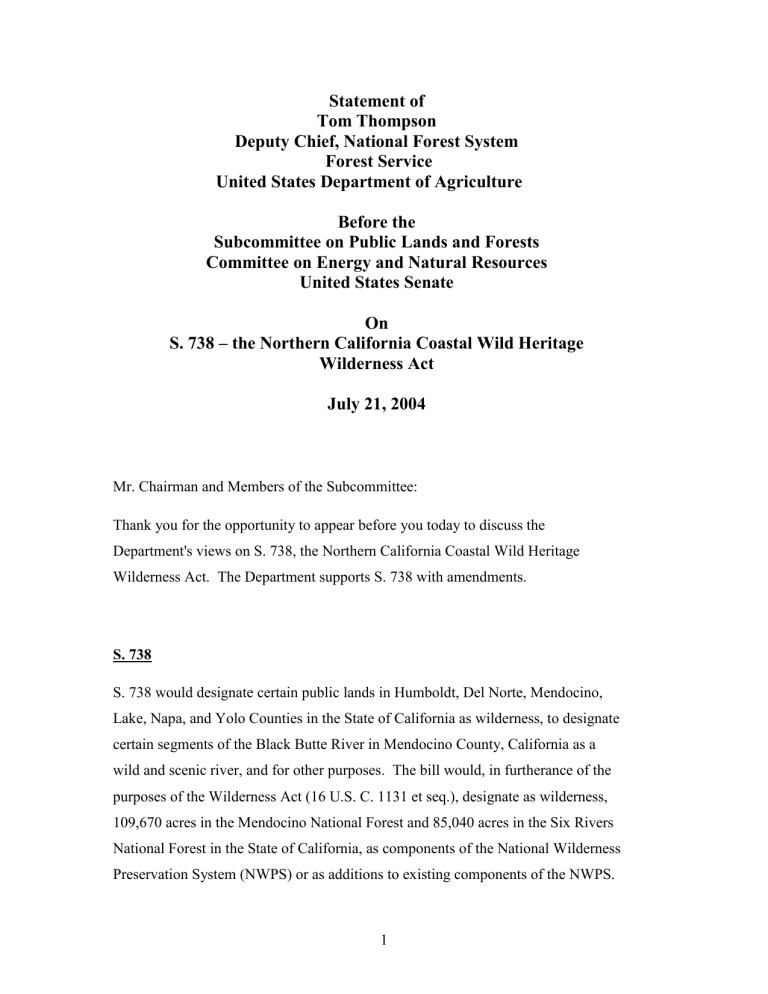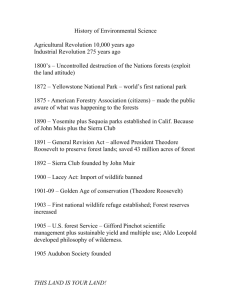Statement of Tom Thompson Deputy Chief, National Forest System Forest Service

Statement of
Tom Thompson
Deputy Chief, National Forest System
Forest Service
United States Department of Agriculture
Before the
Subcommittee on Public Lands and Forests
Committee on Energy and Natural Resources
United States Senate
On
S. 738 – the Northern California Coastal Wild Heritage
Wilderness Act
July 21, 2004
Mr. Chairman and Members of the Subcommittee:
Thank you for the opportunity to appear before you today to discuss the
Department's views on S. 738, the Northern California Coastal Wild Heritage
Wilderness Act. The Department supports S. 738 with amendments.
S. 738
S. 738 would designate certain public lands in Humboldt, Del Norte, Mendocino,
Lake, Napa, and Yolo Counties in the State of California as wilderness, to designate certain segments of the Black Butte River in Mendocino County, California as a wild and scenic river, and for other purposes. The bill would, in furtherance of the purposes of the Wilderness Act (16 U.S. C. 1131 et seq.), designate as wilderness,
109,670 acres in the Mendocino National Forest and 85,040 acres in the Six Rivers
National Forest in the State of California, as components of the National Wilderness
Preservation System (NWPS) or as additions to existing components of the NWPS.
1
S. 738 would also designate 3 sections (21 miles) of the Black Butte River in
California as part of the Wild and Scenic River system.
The Department supports S. 738 if amended. First, the findings listed in the bill need to be clarified and renumbered. For example, section 2(4) for military activities identifies “testing and evaluation, and other activities” which is not clear or defined. This finding may lead to activities that could be conducted which are inconsistent with wilderness areas. Also, “pristine ecosystems” in section 2(6)(G) needs to be changed as this definition is not defined in the Wilderness Act. The
Department suggests using the wording, “natural, undeveloped, or untrammeled”.
Second, the Department believes some of the provisions in S. 738 are redundant with direction already provided in the Wilderness Act of 1964. Section 102(j) specifically identifies horses as a use in the proposed wilderness area. This section could be misconstrued as the use of horses should not be specifically identified over other accepted recreation uses of wilderness areas.
Third, the Department would like to work with the bill sponsors, the committee, and the Department of the Interior on language dealing with fire management activities and fire use as the Forest Service already has developed protocols for delegating responses during a fire emergency. Also, boundary designations should be reviewed and changed as conflicts may occur in implementing mechanical treatments to reduce fire risks.
Fourth, section 102 needs to clarify some of the uses that would be allowed if S. 738 is enacted. For instance, the bill is unclear if new snow sensors and stream gauge could be installed, what law enforcement activities would be permitted consistent
2
with a wilderness area designation, why water resource projects need to be included in a wilderness designation, and when commercial outfitting is a proper activity to be conducted in a wilderness area.
Finally, the Department is concerned with title 2 and 3 in the bill which would require a fire management plan and report on the cultural and historical resources within the Black Butte River segments designated in the bill; authorize funding to promote tourism and recreation in a wilderness area; stipulate how Native
Americans can request to use an area for traditional cultural and religious purposes; and authorize funds for the acquisition of inholdings. These provisions have the potential to conflict with current policies and laws and are duplicative in some instances.
3






